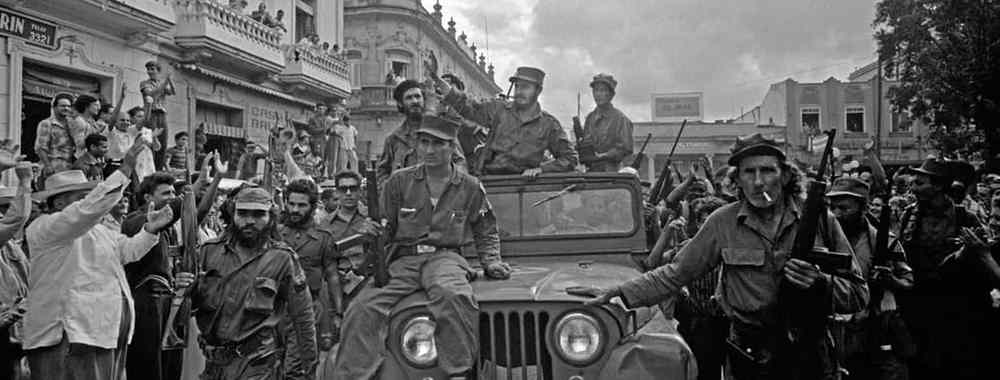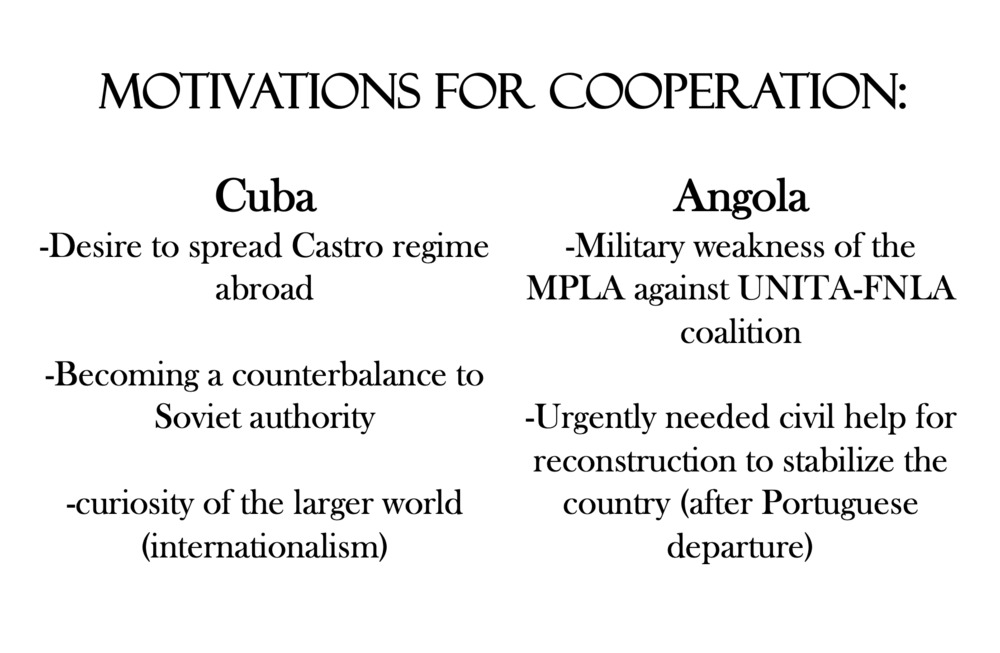Case Study: Cuban Intervention During the Angolan Civil War, 1975-91
The Revolution Reimagined
When you consider the Cuban Revolution, what comes to mind? For Cubans, the year 1959 marked the small Caribbean island nation as an officially successful post-colonial communist state. But while it gradually evolved into a Marxist experiment, the Revolution was ultimately first and foremost a nativist event, Westad reminds us [1]. One which built upon years of distaste toward imperial rule, and which served to exemplify the idea that all Latin American nations could be free from American control [2].
At the core of Castro’s revolutionary spirit was thus a genuine belief in the desire to set straight Cuba’s outdated precolonial policies, which allowed predatory parties such as the United States to embed themselves within the Cuban diaspora in the first place [3]. One major change Westad identifies concerning a change in Cuban foreign policy manifests following the Cuban leadership’s disappointment with Soviet capitulation during the 1962 missile crisis [4]. Thus far, the survival of Castro’s state had hinged on the ideological strength of his revolution and support from the Soviet Union against American advances. But by 1963, Cuba was able to begin distancing itself from the timid Soviet Union, which hesitated toward Third World international communist support, and instead pursued the rising tide of revolution around the world as not just a duty and historical necessity, but likewise a forward defence against the United States [5]. American anxieties largely characterized the Cuban spirit, in other words. In helping rise from the ashes of postcolonialism new communist states worldwide, the United States would likely find itself having to diminish its interest with Cuba, and that same year, in 1963, Castro would send his first batch of military support to Algerian President Ben Bellah.
Cuban interventionism in Africa, therefore, is hardly a product of Soviet influence, if any at all. In fact, it was Cuba who carried the ideological torch which they believed the Soviet Union had failed to uphold [6]. As we will see, Cuban-Soviet relations concerning how to support African communist revolutions tended to consistently differ, and so trying to understand Cuban prerogatives from a Gaddesian orthodox perspective misattributes the situation entirely. Cuba was not serving the Soviet Union, nor was it obedient to the political actors it was helping, either. In fact, quite often would Castro find himself on the opposing side of a decision than his allies.
Angola and Cuban Interventionism
Cuban-Angolan relations dated back to as early has the late 1950s. MPLA soldiers, who had been in Algeria during the Sand War, received training from Cuban soldiers in Algiers, and Che Guevara met the MPLA leader Agostinho Neto for the first time. After the Cubans had established their mission in Congo in 1965, minor aid began to be provided to the MPLA, marking the beginnings of a 26-year-long alliance [7]. But things soon cooled as Havana redirected its focus toward Guinea-Bissau and the MPLA was casted aside for the moment. It was only following the Portuguese Revolution in 1974 that Cuban attention returned to the coastal colony. The next year, Portuguese withdrawal from Angola and Mozambique spurned forth the South Africans who were themselves caught in suppressing an independence struggle in neighbouring Namibia.
On this topic, Piero Gleijeses has put together masterful work demonstrating the agency of Cuban involvement in southwest Africa, Conflicting Missions: Havana, Washington, and Africa, 1959-1976 (Chapel Hill: University of North Carolina Press, 2002); and Visions of Freedom: Havana, Washington, Pretoria, and the Struggle for Southern Africa (Chapel Hill: University of North Carolina Press, 2013) [8]. Following Westad, his thorough archival research corroborates the idea that Cuban actions rested largely on anti-American sentiment stemming from long before the Revolution. A core-periphery relationship [9]
The major decision that led to Cuban intervention in Angola was South African aggression beyond colonial Namibia. As South Africa was directly supported by the United States, fighting them gave Castro a chance to fulfill twofold his desires; he could support communist revolution AND fight American imperialism at the same time [10]. Indeed, combatting United States-backed initiatives through supporting non-Western revolutionaries remained a prescient part of the Cuba prerogative in Africa, yet the United States was hardly paying any attention to Cuban activity on the continent prior to 1975. And when they did engage, it was more so out of regard to the American general position in Africa, not specifically to hinder Cuban efforts [11]
Prior to Che Guevara’s trip to the Congo in 1975, Gleijeses further reveals, the Cubans knew remarkably little about Africa, which led them, in turn, to gravely misread the nature of revolution therein [12]. Castro and his advisors mistakenly thought they could collaborate with the Congolese guerrillas whom they regarded as insurgent, and a failure to establish secure communication between Che in the Congo and Havana further thwarted plans as the Cubans were left in the dark as to his whereabouts for over three months [13]. As such, in reaching Angola, Cuban endeavors in the continent were just as much shaped by their anti-American revolutionary ideology as they were by local events.
What they were not shaped by was top-down Soviet influence.
The Enemy of My Enemy...
It is safe to say that the Soviet Union and Cuba did not exactly see eye to eye on how to approach African foreign affairs. Never was this perhaps more apparent than during the Angolan Civil War.
One undeianble conclusion Gleijeses's research presents is that Cuba was a much stronger supporter of the Angolan government than was the Soviet Union. In fact, in 1977, Cuban intervention foiled a dubious, Soviet-backed coup attempt, protecting the frail MPLA government from certain extinction in the process. Further, Cuba was prepared to retain its military presence in Angola, even during instances contrary to Soviet initiatives[14]. The Soviets and Cubans may have been allies, but they were not friends. Anti-Americanism was the only thing properly aligning the two.
Ultimately, the Cuban-Soviet relationship in Angola was characterized by a remarkable lack of communication [15]. Not only with each other, that is, but with the Angolans as well: in 1976, Cuba failed to notify the Soviet Union ahead of deploying troops to Angola; in 1984, Castro chastized Angolan President José Eduardo dos Santos for having "almost never informed us beforehand" of their intentions (239)[16]; and in 1987, the foremost Soviet military official in Angola lied to his Cuban counterpart concerning important planning (394)[17]. Similarly, the Cubans and Soviets could not even agree on the most basic principal of how to implement the correct strategical blueprint in Angola, with the Soviets insisting on training the Forças Armadas Populares de Libertação de Angola (FAPLA) to fight both the South Africans and Savimbi's UNITA, and the Cuban insistence on fighting South Africa themselves [18].
Indeed, it was almost like Cuba, Angola, and the Soviet Union were three individual actors with respective prerogatives outside of a shared ideological mission, and that ascribing them to vague, unhelpful categories, such as "the East," only serves to misrepresent them, in turn...
South-South Cooperation
It was not just soldiers traversing the Atlantic Ocean to fight on African soil, but Cuban teachers, doctors, and tradesmen as well. As Christine Hatzky contends in Cubans in Angola: South-South Cooperation and Transfer of Knowledge, 1976–1991 (Madison: University of Wisconsin Press, 2015) [19], alongside soldiers, "the civil mission of about fifty thousand Cuban...workers and technicians who provided reconstruction aid parallel to the military involvement" had a profound effect on the mindsets of both Cuba and Angola alike [20].
Like Gleijeses, Hatzky is among the new wave of scholars in the post-2000s concerned with Cuban interaction in Africa outside of the Gaddesian lens. Whereas Gleijeses is much more interested in diplomatic and political history at the national level, however, Hatzky proves to be much more of a micro-historian concerned with telling the story of contemporary Cubans and Angolans on the ground.
Hatzky also makes use of an extensive list of primary source material in her work, most impactfully her interviews with over 150 local Cubans, Angolans, and Russians. She effectively corroborates the conclusion of Gelijeses that the relationship between the two small nations was not of major concern by the United States, nor was it the impetus of Soviet foreign policy in Africa. Instead, Cuban motivations for cooperation reflected threefold the desire to spread the Castro regime abroad; the desire to become a counterbalance to Soviet authority; and curiosity of the larger world [21].
The MPLA, meanwhile, required Cuban military intervention for survival, as it was outmatched by the UNITA-FNLA coalition. Similarly, Hatzky notes how Angola was in desperate need of reconstruction post-Portuguese departure. However, Cuban presence in Angola prevented a consistent development of local Angolan infrastructure due to the development of a similar co-dependent relationship to that of Angola and Portugal, hence the expression os bons colonizadores ("the good colonizers") [22].
In this light, the once-colonized Cuba had come full circle in establishing an "asymmetrical" relationship with Angola. Not only was Cuba acting outside of Soviet imperative, but they pseudo-colonized Angola on their own accord. The periphery had become the core. As a result of this asymmetry, the Angolans lost a great deal of sovereignty to the Cubans, including the forfeiture of control over not just their territory, but their fate as well [23].
When Cuba began its swift and abrupt 3-month exit from Angola in 1991, the African nation was arguably no better off than prior to Cuban arrival altogether. Did Cuba help Angola? According to Hatzy, no, not really. But then, was it the guise of help that struck Castro? It must be remembered that Cuba was helping Angola for Cuba's own reasons, not for Angola's sake. They may not have been ruthless imperialists, but a colonist is a colonist is a colonist.
-------------------------------------------------------------
[1] See Westad, "5. The Cuban and Vietnamese Challenges," in Odd Westad, ed.,The Global Cold War: Third World Interventions and the Making of Our Times, 158-207.
[2] Ibid.
[3] These ideas are explored in Gleijeses, Conflicting Missions: Havana, Washington, and Africa, 1959-1976; and Domínguez, To Make a World Safe for Revolution: Cuba's Foreign Policy.
[4] Westad, "5. The Cuban and Vietnamese Challenges," 175.
[5] Ibid 170-207.
[6] Ibid 176. West explores the idea of "Soviet timidness...which Castro in his mind connected to its Europeanness."
[7] See Edward George, The Cuban Intervention in Angola, 1965–1991 (New York: Frank Cass, 2005) 22-23, 30, for further elaboration.
[8] See Gleijeses, Conflicting Missions: Havana, Washington, and Africa, 1959-1976; and Visions of Freedom: Havana, Washington, Pretoria and the Struggle for Southern Africa, 1976-1991 (Chapel Hill: University of North Carolina Press, 2013). See also “Moscow’s Proxy? Cuba and Africa 1975–1988,” Journal of Cold War Studies 8, no. 2 (2006): 3–51; and “The First Ambassadors: Cuba’s Contribution to Guinea-Bissau’s War of Independence,” Journal of Latin American Studies 29 (1997): 45–86.
[9] Ibid.
[10] Ibid.
[11] Ibid.
[12] Ibid.
[13] Ibid.
[14] Ibid.
[15] Gleijeses, Conflicting Missions, 335.
[16] Ibid, 239.
[17] Ibid, 394.
[18] Ibid, 241-249.
[19] See Christine Hatzky, Cubans in Angola: South-South Cooperation and Transfer of Knowledge, 1976–1991 (Madison: University of Wisconsin Press, 2015); and “‘Os Bons Colonizadores’: Cuba’s Educational Mission in Angola, 1976-1991,” Safundi 9, no.1 (2008): 53–68.
[20] Hatzky, “‘Os Bons Colonizadores’," 53.
[21] Ibid, 55.
[22] Ibid, 64.
[23] Ibid, 63.




